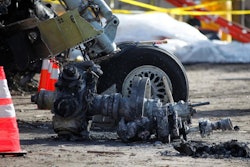Keeping production equipment reliable is a core function of any factory management team. As equipment ages, unscheduled downtime becomes a real challenge with many variables.
Collecting data is a great start to solving this challenge. Tracking when, how, and how often machines fail enables engineers and maintenance techs to not only respond faster, but to also predict expensive downtime. With nearly fifty percent of all maintenance and repair work orders requiring a spare part, parts availability also becomes extremely important. Without linking past failure trends with the accurate planning of MRO (Maintenance Repair and Operations) inventories, operations will be negatively affected.
Many manufacturing organizations make MRO inventory decisions that result in increased and unnecessary costs. To mitigate risks (and perhaps avoid a repeat of a costly downtime incident), decisions are made to invest in unnecessary inventories as an insurance policy. As a result, as much as 60 percent of MRO parts inventories are inactive, providing no ROI. This leads to financial managers looking at MRO as an easy target for budget reductions.
Ensuring the reliability of complex, yet essential equipment and maintenance spare parts is the core value of a Repairable Parts Management (RPM) program. Repairable Parts Management is a data-driven approach that continually improves part reliability and the reliability of production assets.
An effective RPM program has two distinct differences: root cause analysis and rebuild/remanufacture methodologies. Root cause analysis seeks to uncover hidden or unique factors behind repetitive part failures. Once a critical part fails, the component is bagged, barcoded, and sent to an appropriate repair center where detailed failure analysis is performed. Reliability engineers look for telltale signs of overvoltage, materials fatigue, seal degradation, environmental factors, and human errors.
Rebuild/remanufacture methods, the second RPM advantage, reduces repetitive failures by implementing detailed repair and preventative maintenance procedures that address defined root causes. Where appropriate, RPM technicians repair and upgrade the part using premium components that exceed OEM specifications. This enables the part to perform better in the end user’s specific environmental conditions.
Finally, after the repair process is complete, the part is shipped back to the customer with a detailed report outlining the root cause(s) and specific repair methods used to repair and rebuild the part back to OEM specifications. The report will include recommendations to eliminate installation failures, environmental related conditions (e.g., waterproof enclosures), and/or opportunities for training.
Successfully implementing RPM requires planning and commitment. Here are four keys to building a strong RPM program:
Establish a vision for how the RPM program creates value for the organization. MRO is an investment for any manufacturing company, so it’s beneficial to understand how to reduce MRO costs as a result of implementing a RPM program.
For example, a RPM program based solely on reducing purchase price is much different, and less valuable, than a RPM program with a vision to improve reliability, improve uptime, and extend the life of aging or obsolete MRO assets. Some organizations make repair-or-buy decisions based on whether the price of the repair exceeds 50 percent of the price of a new purchase. Others consider factors like warranty, reliability, availability, and potential impact on production. While the process to establish the vision will vary, each organization must determine for itself which factors are most important and implement its RPM program accordingly.
Change the cultural paradigm that repaired components are not as reliable as new. While it’s true that less-than-reputable repair businesses can negatively affect parts performance, most vendors work hard to earn their reputations for quality. When comparing potential RPM partners, look for evidence of documented repair and quality control procedures. Vendors should also be vetted for their commitment to overcoming repetitive parts failures with innovative repair testing and development solutions.
Most important of all, there should be alignment on objectives. Because no two companies view MRO value the same way, the RPM vendor needs to be flexible. With the right partner, RPM can transform a factory’s maintenance culture. This is an opportunity that should be encouraged before, as well as after, the program is instituted.
Evaluate internal processes and systems to achieve the RPM vision. Whether the vision is to reduce parts spending, extend TCO, or improve reliability, it’s important to plan for change. Organizations need to first define and create a clear understanding of the opportunity, then create processes tailored to that opportunity. Performance measures and continuous improvement procedures are also important.
Measures based on repaired items (mean time before failure, warranty tracking, failure modes, etc.) will lead to better judgements on whether to develop capabilities internally or to outsource. Maintenance and purchasing staffs need to collaborate to design and/or improve processes, whether those steps involve flagging parts as repairable or implementing more extensive opportunities provided by the RPM partner.
Motivate all parties to contribute to the program’s long-term value. Everyone affected by the RPM program has a vested interest in its success, so it pays to emphasize the incentives and benefits. For Engineering, RPM drives more reliable processes and greater availability. For Purchasing, the program provides increased cost savings and lower MRO costs. Finance enjoys lower inventory cost, lower overhead, and more favorable operating costs. And Maintenance should experience less reactive work and more proactive machine repair planning (while helping to offset staffing and skill set shortages).
Each department in the organization should be made aware of the significant advantages of RPM—and the roles, responsibilities and expectations they have in the program’s success. Doing so ensures a broad base of support and assists in solving whatever challenges may arise.
In all phases of RPM, it helps to have current and complete data. A Computerized Maintenance Management System (CMMS) is important to this effort, as it allows staff to track work orders and consumed parts, complete pareto analyses, and understand other environmental conditions. Successful systems are set up for easy data entry and are structured to support the company’s workflows and maintenance priorities (e.g., tracking the same class of motor across multiple work orders). By thinking long-term about maintenance objectives and structuring your RPM and data-gathering activities accordingly, you can not only reduce your downtime, but also extend your equipment life — and keep improving your factory productivity over the long-term.
Mike Waltrip is Vice President of Industrial Parts & Services for Advanced Technology Services.






















